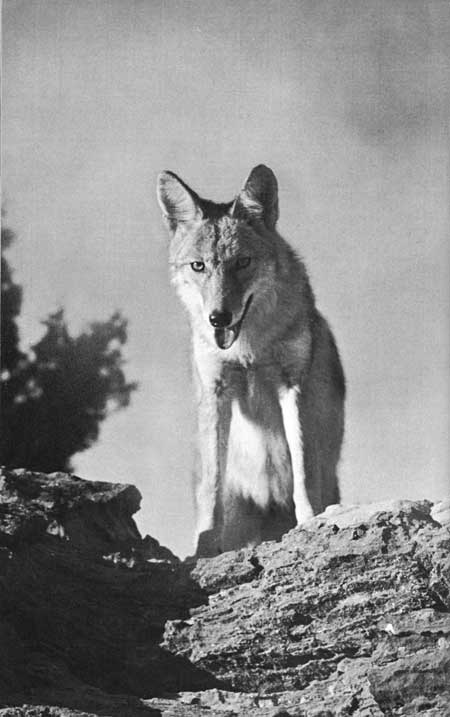|
ORGAN PIPE CACTUS National Monument |
 |
Animals
AS ONE ECOLOGIST has written, "The more than a million species of living things on this earth form an incomprehensibly complex and intricate pattern of life. The pulling of a thread here, or the cutting of a skein there, no matter how small, may cause knotting, warping, or even ravelling of the delicate fabric at some wholly unexpected place." Thus the intricate mingling of plant and animal life in the various habitats, themselves influenced by geological conditions of the monument, might be irrevocably altered by the continued interference of mankind. It is to prevent just such disturbance of the orderly balance of nature that this outstanding section of desert has been preserved through permanent protection.
 Occupants of the monument campground often hear coyotes howling at night. Courtesy, U.S. Fish and Wildlife Service. |
Animals to a degree are dependent upon each other, upon certain plants, and upon climate and other natural factors favorable to their living requirements. They become established where these suitable conditions prevail and where other animals (and the plants essential to their welfare) are abundant. Thus, throughout the desert, there are extensive or restricted communities of plants and animals called biological associations. We may expand our understanding and enjoyment of the desert if we will look upon plants, mammals, birds, reptiles, insects, and all other inhabitants of the desert not only as interesting individuals but also as parts of a complicated and interdependent living whole.
We are already familiar with the fact that there are three subtypes of the Sonoran Desert represented within the monument, each with plant associations not found in the other subdivisions. Closer inspection reveals that these groups may include even smaller and more closely knit units, or microcommunities. For example, some plants support colonies of aphids, and certain ants collect the aphids' sweet exudations. There are even smaller organisms parasitic or dependent upon the ants.
Because of their greater mobility, many animals, especially the birds and the larger mammals, are not restricted to any particular environment and may be found among several distinct types of desert plant associations, sometimes frequenting one type during the winter and moving to another in summer. Both the turkey vulture and the black vulture are a common sight soaring over all parts of the monument or congregating, as if informed by built-in television, at the spot where a luckless animal has succumbed to thirst, famine, wounds, or the relentless processes of age.
Oases form a special kind of environment, for they are visited by many birds and mammals that make their homes in other habitats. Birds, especially, often come in large numbers. The 1-1/2-acre pond at Quitobaquito, a dependable, year-round water source, draws hundreds of individual birds as well as a wide variety of species. As many as 400 white-winged doves may take advantage of the oasis during a single day in late May or June. Mourning doves and brown-headed cowbirds also come in numbers to drink and then rest in the shade among the branches of trees that border the pond.
Dr. Max Hensley, who conducted extensive studies of bird activity in the monument during 1948-49, reports a count of 477 individual birds, representing 22 species, at the pond in a single day. He recorded a total of 59 species at Quitobaquito. Most of these apparently came to the pond for refreshment, for only 15 species nested in the immediate vicinity. Of these, the killdeer was the only one apparently requiring the proximity of water for raising a family.
Among the winged visitors at the Quitobaquito oasis are shore and water birds that stop there for a few hours, or sometimes several days, during their cross-country migrations. These include grebes, herons, and wood ibises; mallard, teal, redhead, and lesser scaup ducks; coots, snipes, and 5 species of sandpipers. Even kingfishers have been recorded, their visits being explained by the presence of a small fish, the desert pupfish.
These little fish are slate gray except during the breeding seasons, when the bodies of the males become bright blue and the tails turn lemon yellow to orange yellow. Then, the males are noticeably active in defending bits of territory against other males. Of all desert fish, these are best adapted to endure temperature extremes from a few degrees above freezing to over 100° F., and they can live in water with relatively high salt content.
Black phoebes and vireos, warblers, and swallows of several species are among the birds attracted to the oasis by the abundance of dragonflies and other insects which find food or breeding sites in or around water.

|

|
| NPS History | History & Culture | National Park Service | Contact |
|
Last Modified: Sat, Nov 4 2006 10:00:00 pm PST |


